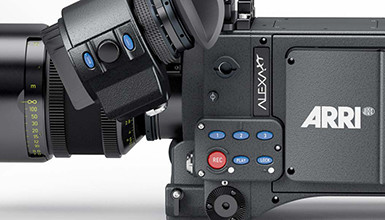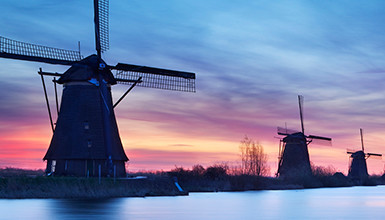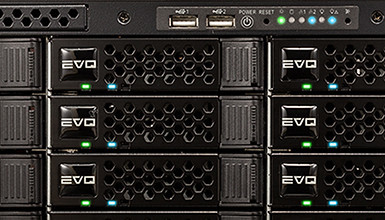So... is film dead now?
Pundits have been predicting the end to film as a production medium for decades, but now it seems that the writing is on the wall. Digital Cinema camera technology has advanced to the point that nearly all production for television has moved to electronic acquisition.
Currently the majority of high-end features are still produced on 35mm film, but it appears only a matter of time before this completely transitions as well. Most lower- to medium-budget productions are already being shot digitally, and numerous notable high-end productions are as well. In particular, shooting digitally for 3D productions is significantly more advantageous compared to film.
This has also spurred the rollout of digital projection, as this is again far easier to accomplish for 3D presentation. The final nail may be the financial advantage to studios distributing movies digitally rather than with film prints. Fox has already notified theater chains that it plans to eliminate film prints sometime next year.
Without the steady income stream of film prints, plus TV and commercial production, the economic model supporting film stock producers and processing labs will eventually no longer function. We may look back on 2011 as the last year film had a significant, dominant position in the industry, before becoming relegated to "niche" productions.
What are people shooting with?
It's no secret that it is a 35mm-sized sensor world right now. Many have desired the large sensor look for years, starting perhaps with the Pro35 optical adapter, which debuted only a relatively short time after the venerable Sony F900 made HD a serious option. Many cameras and many adapters followed, with the ARRI D21, Panavision Genesis, Sony F35 and Phantom HD taking the highest-end market, thanks to their more direct approach of native Super-35 sized sensors. The RED One, followed by the Canon HDSLRs, made affordable large sensor production a reality, and much of the production community quickly switched over.
This transition happened even though many of these productions were in fact poorly served in making this change to a larger sensor. Sometimes a smaller sensor camera is preferable for certain work, and often a certain form factor and workflow is more appropriate for particular shooting styles. But the sudden shift certainly alerted manufacturers as to how strong the desire in the community was to shoot on larger sensor cameras. So 2011 was the year that refined Super-35 sensor cameras took over the industry.
Released in 2010, but largely available in 2011, the ARRI ALEXA took over much of the episodic television production market in the US, as well as abroad. The ALEXA cameras also made significant inroads into the medium- and even high-budget feature world, with notable productions such as Drive, Extremely Loud & Incredibly Close and Hugo, which was also a dual-camera 3D production. RED's EPIC and then Scarlet cameras began to ship in sizable quantities in 2011, some directly to studio feature productions. The ALEXA Studio model features both an optical viewfinder with spinning mirror shutter and a large 4x3 shaped sensor to properly accommodate anamorphic lenses.
On the more affordable end of the production market, Panasonic's AF100 arrived just at the start of 2011, followed by the Sony PMW-F3 in February and then the Sony FS-100 in May. These Compact Cine cameras answered many of the needs filled by the HDSLR market, but did so as proper video production cameras, with controls and form factors better suited to professional production.
In a telling sign of the changing expectations of the marketplace, Sony offered the F3 with 4:4:4 Uncompressed HD output in S-LOG, a refined level of video signal previously only available on cameras four times as expensive. These cameras quickly became wildly popular with our clients, as many happily relegated their recent HDSLR purchases to B-roll and home movie status. Productions no longer asked about "film v. F900" but instead "ALEXA v. F3."
Announced in 2011 and shipping this month, two more cameras will spur all levels of production. Canon's C300 brings the company into the professional video production community with their first Compact Cine camera. Mixing the community's desire for a more professional camera system with the conveniences and form factor that Canon has learned from decades of manufacturing still cameras, the C300 is a unique camera platform that promises to have a significant impact on the industry.
Meanwhile, Sony has raised the bar at the highest level of production with the F65 Digital Cinema camera, which features an unprecedented 20 million photosite sensor that the camera can use to capture a "true 4K RAW image."
Another interesting aspect of these S-35 sensor cameras is that they break previous sensitivity and dynamic range barriers. Just a few years ago 320 ISO and eight stops of exposure range was the norm. Now it is "the new black" to have 800 ISO native sensitivity with a noise floor low enough to push a few more stops and an exposure range from 11 to an amazing 14 stops. I don't know when I'll need to dial up a camera to 20,000 ISO and still expect to see even further into the shadows while retaining bright details, but it's nice to know it can be done.
What about the glass?
Lens choice used to be dictated by format, and generally there were only a few options. This has changed dramatically as new players have entered the field and cameras opened up to different options. In PL, it used to be Zeiss or Cooke primes and Angenieux zooms. Now Illumina, Leica, RED, Schneider, Sony and UniqOptics have introduced primes, while both Cooke and Zeiss have new, additional sets of primes.
Angenieux practically owned the market on 35PL zooms for years, with only a few lenses from Cooke available. Angenieux introduced another zoom (45-120) this year, and there are now, or will soon be, 15 different PL zooms from ARRI/Fuji (Alura series), Canon, Duclos Lenses, Focus Optics, Fuji (Premier series) and RED. That is just in PL mount, but one great outgrowth of the two-year HDSLR wave was that clients became comfortable with the options of relatively inexpensive stills lenses from manufacturers such as Canon, Nikon, Leica, Tamron, Tokina and Zeiss.
Compact Cine cameras from Panasonic and Sony have very shallow mounts, allowing room for various adapters so that an assortment of optics old and new could be mounted. At AbelCine we developed our HDx Optical Adapters so that 2/3" B4 mount lenses could be used on these cameras, which allowed our clients used to the extreme zoom ranges available in 2/3 to shoot with these new cameras.
This new generation of interchangeable mount/interchangeable lens cameras has created a new interest in optics and the various capabilities and choices available. There's so much more to it than a focal length and an f-stop, and with a sudden array of choices presented to them, cinematographers have to become versed in the options. While some might be considered "lens aficionados," others would accuse them of being "lens snobs" - either way, having more available choices can only be a good thing.
On recording
The lenses and lens mounts became separated from the camera sensors, and so too did the recording format become separated from the camera. Where we were once relatively trapped in uni-body camera designs with all aspects of the camera kit in an "all or nothing" design, 2011 saw the parts pulled apart. Nowhere did this become more evident than with the explosion of camera-mounted small video recorders. While the XDCAM-recording nanoFlash was already available for a year, 2011 saw the first delivery of ProRes (and sometimes DNxHD) recorders like the AJA KiPro Mini, followed by the Atomos Ninja and Samurai, and the Sound Devices PIX220 & 240.
The quality of these codecs is extremely high, higher than anything that had been available on all but the most expensive cameras. In 2011 they became available for just about any proper camera for only a few thousand dollars - this was a major step. Recording in a high quality codec which also not-just-so-happened to be the native format for the most popular editing software meant a major advance in image quality and speed of turnaround, while remaining in a straightforward video production workflow.
One of the keys to the success of the ALEXA camera is its ability to record internally directly to ProRes (DNxHD coming soon). If you wanted an even higher quality recording, then there were the new options of Convergent Design's Gemini 4:4:4 uncompressed full sampling recorder and the Blackmagic Design HyperDeck Shuttle, which can record an uncompressed 4:2:2 signal. The ability of the ALEXA cameras to record to ProRes makes for an interesting study in the difference between perception and practice within the industry.
The ALEXA and ALEXA Plus have a native resolution of 2880x1620 and can output an Uncompressed RAW image file, but almost everyone shoots with the signal converted to video and super-sampled to 1920x1080. Then that resolution is compressed into ProRes, either in 4:4:4 12-bit or 4:2:2 10-bit. Why knock it down so much? Because it's easier. The most common functional resolution of production today is 1920x1080; it is what we generally finish to and present in.
By converting to ProRes, one can load the material directly into a laptop and edit in real-time with no transcoding or additional processing needed. With all production time is money, and the more streamlined the post-production path the easier, and therefore less expensive, the proposition. The proof is that ALEXA has taken over the vast majority of television series production, almost all in ProRes 4:4:4.
The Monolith known as "Post Infrastructure."
Post facilities have long been complexes of machine rooms with multi-million dollar suites featuring fancy hand-installed and lovingly-maintained Rolls-Royce-level finishing systems. Through glass doors one could see positive-pressure machine rooms stuffed with racks of shiny signal processors, converters, routers, decks, deck controllers, signal generators, scopes, regulators, etc.
Many of these "heavy metal" facilities were based on the workflow of a tape-based system, namely Sony HDCAM SR. This format is the recording medium for the Panavision Genesis, Sony F35 and Sony SRW-9000, and is also the format of choice for a master deliverable for much high-level video production. The double-whammy of the ease of the ALEXA workflow and the tragic tsunami that destroyed Sony's ability to manufacture HDCAM SR tape for months shifted a great deal of television production away from the HDCAM SR format in 2011.
Now Sony has SRMemory, solid state memory cards that can hold up to a terabyte of information and can read/write at incredible data rates. This allows for the real-time use of high frame rates, high resolution, high bit depth and bit rates, Uncompressed or lightly-compressed files, dual streams of 3D, and much more. It is a forward-thinking format with huge capacity to easily transport enormous amounts of data.
The new F65 will be able to record in either HDCAM SR codecs or 8K Uncompressed RAW files directly to SRMemory cards, and the format may well become the new currency for post facilities the way HDCAM SR tapes and DPX files are now. Other systems may be the story for 2011, but SRMemory may just be the takeaway for 2012 and beyond.
Another trend in Post is how so much of it is being taken out of the hands of the post facilities and moved onto or near to set. But the players keep changing. 2011 was the year of ProRes capture, but it was also the year that saw Apple introduce Final Cut Pro X, an update of the software that made it more like an expanded iMovie program than a next-generation professional editing system. Where does that leave many ProRes and FCP users? Moving to other systems, and just in time Avid introduced Media Composer 6 (Did you miss it? It was the same day that Canon unveiled the C300 and RED announced the new Scarlet camera).
MC6's huge leaps forward, including the new DNxHD 4:4:4, made many re-embrace a company that had been steadily losing traction in the industry due to an aging infrastructure, based on what some perceived to be a closed and antiquated system. IRIDAS was purchased and absorbed into Adobe. Blackmagic Design purchased DaVinci, maker of one of the most advanced set of color finishing systems available. And then BMD stunned everyone by taking DaVinci's premiere product, the Resolve color correction system, and offering low level tiered systems for only $1000, later followed by an entry level version for free. That's a zero-cost access to a powerful finishing tool that used to only reside in $1000/hour post suites. Heavy metal indeed.
Technology is a moving target. Today's expensive top-of-the-line tool is tomorrow's middle-cost meat'n'potatoes tool and the next day's consumer-level tool. It used to be that you could learn a new camera or film stock and then be covered for several years as the glacial pace of the production industry puttered along. Now an iPhone 4S can shoot and post an entire movie in 1920x1080.
Change is faster than ever before, and if we do not keep moving forward we are falling behind.













